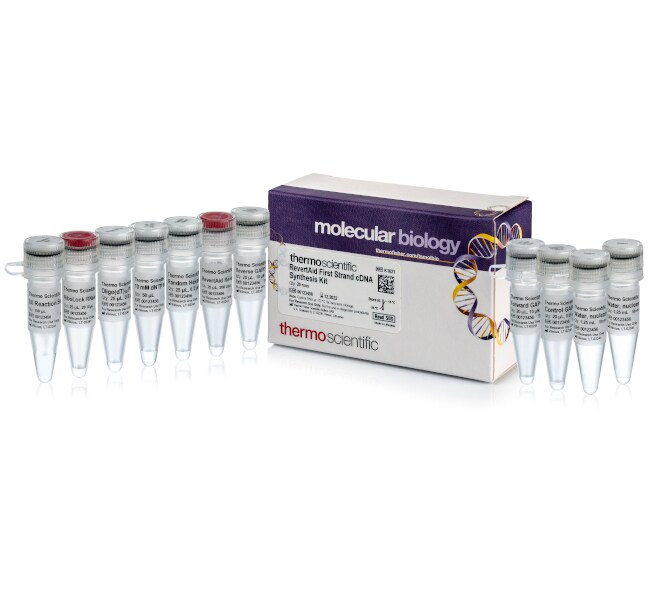Search Thermo Fisher Scientific

RevertAid First Strand cDNA Synthesis Kit
| Catalog Number | No. of Reactions |
|---|---|
| K1621 | 20 Reactions |
| K1622 | 100 Reactions |
Thermo Scientific RevertAid First Strand cDNA Synthesis Kit is a complete system for efficient synthesis of first strand cDNA from RNA templates. The kit uses RevertAid Reverse Transcriptase (RT), a recombinant M-MuLV RT which maintains activity at 42–50°C and is suitable for synthesis of cDNA up to 13 kb. RiboLock RNase Inhibitor, supplied with the kit, effectively protects RNA templates from degradation at temperatures up to 55°C.
The RevertAid First Strand cDNA Synthesis Kit is supplied with both oligo(dT)18 and random hexamer primers. The oligo(dT)18 primer anneals selectively to the poly(A) tail of mRNA. Random hexamer primers do not require the presence of the poly(A) tail; they can therefore be used for transcription of the 5'-end regions of mRNA or cDNA synthesis of RNA species lacking a poly(A) tail (e.g., microRNAs). Gene-specific primers may also be used with the kit.
Radioactively- and non-radioactively-labeled nucleotides can be incorporated into first strand cDNA for use as a probe in hybridization experiments, including microarrays.
Features of the RevertAid First Strand cDNA Synthesis Kit include:
• Full-length first strand cDNA up to 13 kb
• Optimum reaction temperature 42°C
• Complete kit with all components necessary for the RT reaction already included
Applications
• First strand cDNA synthesis for RT-PCR and RT-qPCR
• Construction of full length cDNA libraries
• Antisense RNA synthesis
• RevertAid Reverse Transcriptase
• RiboLock RNase Inhibitor
• 5X Reaction Buffer
• dNTP Mix
• Oligo(dT)18 Primer
• Random Hexamer Primer
• Control GAPDH RNA
• Forward GAPDH Primer (10 μM)
• Reverse GAPDH Primer (10 μM)
• Nuclease-free water
Store at –20°C.